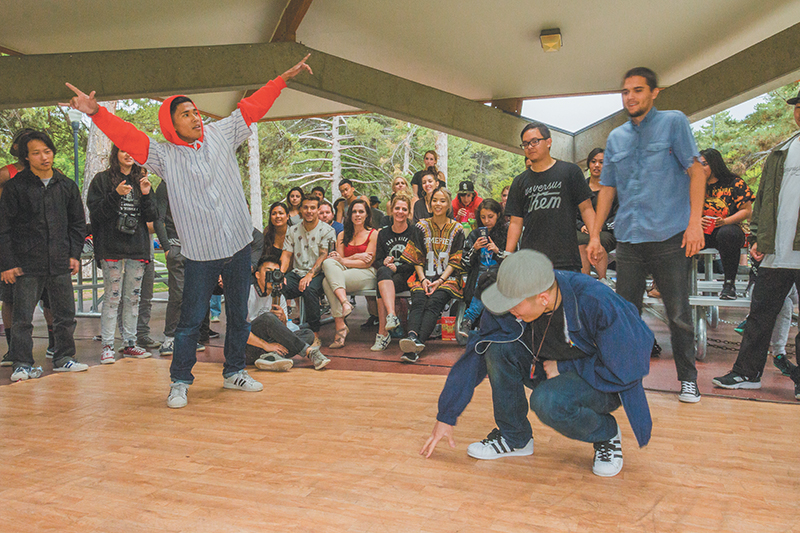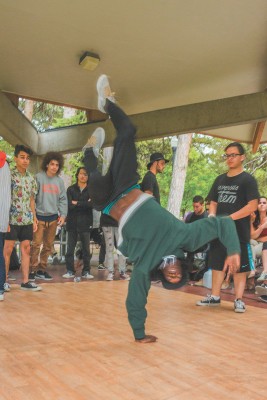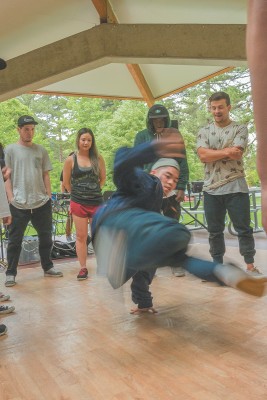
Utah’s Bboy Federation: They Reminisce
Art
It’s difficult for b-boys/girls to get paying gigs compared to their contemporaries in other dance forms. Many try to lure crews in with promises of “exposure” and drink tickets in an attempt to have them do flips and tricks for their patrons. The Fed acts as a liaison for dancers and promoters to make sure that everyone involved gets fair treatment. “If you were to pick a traditional dance form—ballet, jazz, tap, modern—there are a lot of opportunities to start taking [classes] when you’re young, continue taking [them] through high school, go to college and then have a professional career path,” says Perkins. “When it comes to nontraditional dance, there’s not as many of those career-path opportunities—the pathway isn’t as clearly defined.”

Therefore, it is essential that hip-hop be represented on college campuses by the right people and in the right fashion. Mixing academia with air flares is an arduous task, but it’s necessary if hip-hop dancers want to get paid like their contemporaries do. Perkins recalled when he and his friends were getting kicked off campus for breakdancing and having tattoos. Now, they are helping to draft curriculum and teach college students, as they have an avenue to teach hip-hop culture to students who may not be able to attend events due to lack of exposure. The Dance 245 course (Urban and Street Dance Forms) at BYU teaches different hip-hop techniques, breaking, popping and house. The class also educates about hip-hop on a deeper level.
For some college students, Biggie and Tupac were their introduction to hip-hop culture. With the Bboy Fed’s curriculum, they receive a deeper level of hip-hop roots. Names like Mr. Wiggles, Kool Herc, Zulu Nation and the Rock Steady Crew all help to contextualize the dances. “Our BYU class was done in collaboration with Graham Brown [assistant professor of dance]—it’s actually his class,” says Perkins. “He and I got together, and we had some really awesome conversations about what would make this authentic, and we decided that context was really important. It’s not enough to just show up to the class and have somebody teach you how to pop for two or three classes or to new jack or break or house. We wanted to make sure the students were getting context: so, history behind hip-hop culture, history behind each individual dance form and how they’ve evolved and developed.”

Additionally, hip-hop dancers communicate things like their disdain or respect for their fellow dancers through their movements and “exchanges” within performances and battles. “It’s best to think of the class as a language class versus a dance class, or even like an art class,” says Perkins. “We feel like one of the things that separates hip-hop dances from other dances is that you have this direct connection with another person. If you and I are in a cypher together, we have this one-on-one connection.”
To help the casual fan get a better feel for hip-hop through the eyes of a b-boy/girl, the Fed hosts They Reminisce. Think of it as a play with less vocal work and more footwork. “They Reminisce is a stage production that takes place in Salt Lake City … mainly trying to combine elements of history, trying to educate an audience while also putting on a dynamic performance,” says Perkins. The first two years of They Reminisce, the Fed did what they call the three-era show: the origin era, the golden era and the modern era, focusing on hip-hop dances, breaking, popping, new jack, house and choreography. What we really wanted to do was showcase this progression of hip-hop dance and how it has changed over the last 40 years,” says Perkins. “We wanted to educate our audience on the history of hip-hop and who its founders were, and who the important people are and how we got from A to B.”
The third annual show is on July 8 from 5:30 p.m. to 7:30 p.m. and July 9 from 12 p.m. to 1 p.m. as well as a showing later that evening from 5:30 p.m to 7:30 p.m. at the Rose Wagner Performing Arts Center, and this year, it’s a little different than previous showcases. The 2016 production will spotlight a fictional dance crew during the media explosion and the exploitation of hip-hop culture in the ’80s and ’90s—the golden era—instead of the differences between eras and styles. “We’re trying to hover somewhere between a dance recital and a full-blown play,” Perkins says.
Organizations like the Bboy Fed are at the forefront of the movement to percolate hip-hop culture throughout Utah. Anyone who wants to learn more about the culture should definitely keep tabs on them. For tickets to They Reminisce or more information about the Bboy Federation’s other events, such as battles, exhibitions and leagues, visit bboyfed.com.